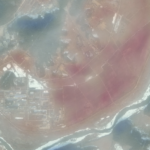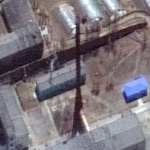July 11, 2022, by Joseph S. Bermudez Jr., Victor Cha and Jennifer Jun—
A high-resolution satellite image from July 3, 2022, shows the current observable status of the Yongbyon Nuclear Research Center, where flooding of the nearby Kuryong River and new activity is observed near Building 500—the first such activity since 2016.
February 18, 2022, by Joseph S. Bermudez Jr., Victor Cha, Andy Dinville and Jennifer Jun—
LANDSAT 7 and LANDSAT 8 thermal infrared satellite imagery in January and February show that warm water is being discharged from the 5MWe reactor at Yongbyon, confirming that the reactor and its cooling system are in operation. Thermal patterns from the same period suggests that the IRT-DPRK reactor, the Radiochemistry Laboratory, and the centrifuge plant are occupied, but not necessarily operational, and not in a state of shutdown.
December 8, 2021, by Joseph S. Bermudez Jr., Victor Cha, Andy Dinville and Jennifer Jun—
Recent thermal infrared imagery of the Yongbyon Nuclear Research Center show warm water being discharged from the cooling system of the 5MWe reactor and that the reactor is in operation. During the past several months, water discharge from the reactor and probable steam exhaust from the steam turbine and electric generator hall has been observed in visible satellite imagery. Through thermal imagery, it can be determined that the water that is being discharged is indeed warm water discharge from the reactor's cooling system.
April 15, 2021, by Joseph S. Bermudez Jr., Victor Cha, Andy Dinville and Dana Kim—
Recently acquired LANDSAT 7 and 8 thermal infrared imagery of the Yongbyon Nuclear Research Center provide strong indications that during March and April 2021, activity involving the heating of buildings and operations of facility support systems had resumed at several locations.
These indications reveal clear patterns, distinct from the surrounding terrain and daily solar heating patterns, that suggest that the Radiochemistry Laboratory, its associated thermal plant, and the centrifuge plant resumed operations during the early part of March 2021 and have continued into mid-April 2021.
March 30, 2021, by Joseph S. Bermudez Jr. and Victor Cha—
At the Yongyon Radiochemistry Laboratory, steam (or smoke) rising from any of the stacks within the radiochemistry laboratory itself is not often observed in commercial satellite imagery. However, the March 30 image shows a plume of steam or smoke emanating from a small support building in the center of the facility. This, while not an indicator of a reprocessing campaign itself, indicates that the building is occupied and being heated.
March 11, 2020, by Joseph S. Bermudez Jr.—
Declassified April 1972 satellite imagery the Yongbyon Nuclear Research Center show developments which taken as a whole continue to represent both an ongoing first-phase construction project for the facility and early infrastructure development efforts within a longer-term plan for future expansion. This work laid the foundations for the construction of the facility’s first waste storage facility in the years to follow and the massive second phase expansion that would begin during the early-1980s.
February 14, 2020, by Joseph S. Bermudez Jr. and Victor Cha—
Satellite imagery acquired on February 14, 2020 shows that the three specialized railcars identified in Beyond Parallel’s report from February 11, 2020 have been moved from west of the Radiochemistry Laboratory to the southern rail yard adjacent to the reported isotope/tritium production facility.
A fourth railcar is present in the latest imagery in addition to the three railcars that were captured in imagery from February 10, 2020.
These railcars have been associated with the movement of radioactive material in the past.
If past practice is any indication, all four cars will leave the Yongbyon facility sometime during the next seven days.
February 11, 2020, by Joseph S. Bermudez Jr. and Victor Cha—
Satellite imagery acquired on February 10, 2020 shows the presence of three specialized railcars that have been associated with the movement of radioactive material in the past. The last observed presence of these railcars by Beyond Parallel was in November 2019.
The size and number of the casks observed on the railcars suggest the outbound shipment of irradiated liquid or solid waste, disassembled but contaminated equipment or, potentially, the movement of fissile materials. A less likely alternative is the inbound shipment of radioactive material.
November 14, 2019, by Joseph S. Bermudez Jr., Victor Cha and Dana Kim—
Recent satellite imagery from November 2019 shows the presence of four specialized railcars that have been associated with the movement of radioactive material in the past. The last observed movement of these railcars by Beyond Parallel was in April 2019. It is unclear whether the railcars are being used for the outbound shipment of irradiated liquid or solid waste, disassembled but contaminated equipment or the movement of fissile material to facilities outside the Yongbyon area. A less likely alternative is the inbound shipment of radioactive material from a facility outside the Yongbyon area.
April 18, 2019, by Joseph S. Bermudez Jr. and Victor Cha—
April 15 railcar movement observed in Airbus satellite imagery at North Korea's Yongbyon facility provides no further understanding concerning the presence of these specialized railcars other that their probable use for the movement of radioactive material.










